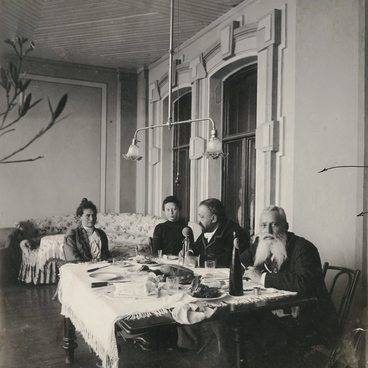A bouillotte is a small metal kettle with a spout or a drain crane. They would place a bouillotte over a kerosene or a spirits burner. They used bouillotte during tea parties, heating the water right at the table, in this respect it resembled the samovar. But, unlike a samovar, a bouillotte had no inner chamber. Therefore, it was mostly used not to boil water, but to maintain the desired temperature.
Bouillotte
Время создания
1911
Размер
26,5x16,8x20,2 cm
26.5x16,8x20.2 cm
26.5x16,8x20.2 cm
Техника
Copper-nickel alloy, wood, casting
Выставка
1
Открыть в приложении#1
Bouillotte
#3
#8
It is not known when bouillottes first appeared. The name most likely comes either from English to boil or from French boullir, which means to bring to the boiling point.
#9
The first bouillottes served to heat water in the field. From the 1760s, under Catherine II, they became an addition to the samovar and a marker of aristocratic luxury: Tula masters manufactured them of silver, copper or valuable alloys. Samovars were massive, they were heated up with wood or coal in kitchens or in the yard, while lighter bouillottes were put on the table.
#10
In the 18th and early 19th centuries, other ways of employing them came into use. They were used to cook grog, mulled wine or punch of red wine with spices, coffee and even eggs for breakfast. One bouillotte was enough to brew coffee for four persons at once. Preliminary heating of water allowed to reduce cooking time. Readiness of the dish could be checked with the help of a special lid in the form of a dome.
#11
In the bouillottes were equipped with a removable frame with cells for boiling eggs. Eggs were prepared in boiling water, the shape of the bouillotte kept them warm for a long time.
#4
The factory inscription Wurttemberg metal factory
#5
The bouillottes were of different shapes. Masters would give them the form of animals and birds, cones, teapots and steam locomotives. Teapots were painted with geometric patterns and plant ornaments, made with straight and bent elements. Some bouillottes were large and could weigh up to three kilograms. Bouillottes were in use until the 20th century. One may consider decorative porcelain teapots, which are heated on a candle, to be the modern analogue of bouillottes.
#12
The bouillotte from the museum collection was manufactured in 1911 at the Wurttemberg metal factory. The factory inscription WMF is preserved on the lid. The bouillotte has curved handles and legs, through holes on the legs form an abstract pattern.
#6
Catalogue cover. 1906
#13
The Wurttemberg factory was founded more than 160 years ago. In 1850 German entrepreneur Daniel Straub established a steel manufacturing factory. In 1853 it merged with the Brother Schweizer firm, which produced metal products. The new company produced and sold silvered teapots, candlesticks, lamps and utensils.
#14
The London International Exhibition of 1862 brought the company a gold medal for silvered candlesticks, trays and vessels for cooling wine of its own design. By 1892 the factory developed wear-resistant utensils. This became possible due to its own, better method silvering. WMF gained widespread popularity, its product catalogues were translated into 12 languages. By 1910 its branches were opened in Warsaw, London and Vienna. The company still exists.
читать дальшескрыть
00:00
00:00
1x
Bouillotte
Время создания
1911
Размер
26,5x16,8x20,2 cm
26.5x16,8x20.2 cm
26.5x16,8x20.2 cm
Техника
Copper-nickel alloy, wood, casting
Выставка
1
Открыть в приложении
Поделиться





